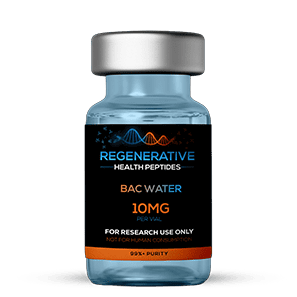BAC Water 3 mL
$5.00
BAC Water 3 mL (Bacteriostatic Water) is sterile, non-pyrogenic water containing 0.9% benzyl alcohol as a preservative, designed for in-vitro peptide reconstitution. Each lot is tested for purity, identity, and professionally labeled in the USA by Regenerative Health Peptides. Research use only, ideal for researchers looking to buy BAC water online from a trusted US peptide store.
Overview
Bacteriostatic Water (BAC Water) is sterile water for injection with 0.9% benzyl alcohol, conferring bacteriostatic activity to prevent microbial growth during multiple withdrawals. In peptide laboratories, BAC Water helps maintain solution integrity during in-vitro reconstitution of lyophilized compounds. This 3 mL presentation supports precise dosing in small-volume peptide studies.
Composition & Specifications
| Parameter | Specification |
|---|---|
| Active Preservative | Benzyl alcohol 0.9% (v/v) |
| Solvent | Sterile, non-pyrogenic water |
| Fill Volume | 3 mL (multiple-use vial) |
| pH Range | ~4.5–7.0 (USP) |
| Osmolality | Hypotonic |
| Container | Sealed sterile vial (latex-free stopper) |
How It Works (Mechanism of Preservation)
- Benzyl Alcohol Action: Disrupts microbial cell membranes and protein conformation, exerting bacteriostatic effects against common lab contaminants.[1–3]
- Multiple Withdrawals: The preservative supports repeated vial access under aseptic technique (unlike preservative-free sterile water, which is single-use).[4]
- Compatibility: Demonstrated chemical compatibility with many peptides under controlled conditions; however, researchers should validate stability for each specific compound.[5–7]
Research Areas & Applications
- Peptide Reconstitution & Stability – BAC Water is commonly used to dissolve lyophilized peptides for in-vitro assays, allowing short-term storage after reconstitution.[8–10]
- Aseptic Sampling Techniques – Supports multiple withdrawals for ongoing experiments while limiting bacterial proliferation.[11–12]
- Formulation & Solubility Studies – Investigators assess peptide solubility profiles, pH tolerance, and benzyl alcohol interactions.[13–14]
- Microbial Preservation Efficacy – Benzyl alcohol’s antimicrobial effect has been benchmarked against USP standards for multi-dose containers.[2, 15]
- Stability Under Cold Storage – Research shows that benzyl alcohol–containing solutions maintain sterility but may impact long-term peptide integrity; proper aliquoting is advised.[6, 16]
Product Usage
This BAC Water is for Research Use Only. It is not intended for human or animal administration and is supplied solely for in-vitro laboratory studies (Latin: in glass). Any other use is strictly prohibited. Not evaluated by the FDA to diagnose, treat, cure, or prevent any condition.
Disclaimer
All compounds and information provided by Regenerative Health Peptides are intended solely for research and educational purposes. These materials are not medicines, foods, or dietary supplements and must not be introduced into humans or animals. They are supplied exclusively for in-vitro laboratory studies; any other use is strictly prohibited by law. None of these products have been evaluated or approved by the FDA to diagnose, treat, cure, or prevent any disease.
2.1 Preservative Efficacy & Standards
Benzyl alcohol at 0.9% meets pharmacopeial criteria for antimicrobial effectiveness in multi-dose parenterals.[1–3] Studies comparing preservative systems confirm benzyl alcohol’s broad utility across pH ranges typical of peptide solutions.[15, 17]
2.2 Compatibility with Peptide Reconstitution
Investigators report that BAC Water maintains peptide solubility and sterility for short-term in-vitro work; however, some peptides exhibit reduced stability in alcohol-containing diluents, necessitating pilot testing and aliquoting strategies to avoid multiple freeze–thaw cycles.[5–7, 18]
2.3 Sterility, Pyrogen Control & Aseptic Handling
USP and FDA guidelines emphasize sterile preparation, pyrogen testing, and aseptic technique. Even with benzyl alcohol, improper handling, needle reuse, or prolonged storage beyond recommended limits increases contamination risk.[4, 11, 19]
2.4 Storage & Stability Considerations
While benzyl alcohol extends usable life, most labs follow a 28-day beyond-use guideline post-first puncture, with refrigeration to slow degradation and microbial growth. Peptide stability data suggest aliquoting into sterile vials to minimize repeated vial entries.[6, 16, 20]
2.5 Safety Notes in Research Context
Benzyl alcohol has known toxicity in neonates and is strictly contraindicated in human neonatal applications (“gasping syndrome”). In research, this underscores the importance of research-only labeling and clear delineation from clinical or veterinary use.[21–23]
Reference List
- USP Monograph: Bacteriostatic Water for Injection (USP 43–NF 38)
- Mooradian AD et al., Am J Ther 4, 333–344 (1997)
- Sutton SVW., PDA J Pharm Sci Technol 54, 238–249 (2000)
- FDA Guidance for Industry: Sterile Drug Products Produced by Aseptic Processing (2004)
- Serno T et al., J Pharm Sci 99, 439–451 (2010)
- Wang W., Int J Pharm 289, 1–30 (2005)
- Liu J et al., J Pharm Sci 102, 3005–3030 (2013)
- Manning MC et al., Pharm Res 17, 1350–1361 (2000)
- Rosenberg AS., AAPS J 8, E501–E507 (2006)
- Shire SJ et al., Adv Drug Deliv Rev 60, 1251–1262 (2008)
- CDC: Injection Safety & Multi-dose Vials (2017)
- Ryan MJ et al., Am J Health-Syst Pharm 58, 115–121 (2001)
- Khan NA et al., J Pharm Pharmaceut Sci 3, 234–242 (2000)
- Lundstedt-Enkel K et al., J Chromatogr B 877, 1737–1744 (2009)
- Kramer A et al., GMS Hyg Infect Control 15, Doc14 (2020)
- Brange J et al., Pharm Res 9, 715–726 (1992)
- Mitsuhashi S et al., J Parenter Sci Technol 44, 111–115 (1990)
- Harris RJ., J Pharm Sci 93, 2969–2979 (2004)
- WHO Annex 6: Good Manufacturing Practices for Sterile Pharmaceutical Products (2011)
- Carpenter JF et al., Pharm Res 24, 404–416 (2007)
- Gershanik J et al., N Engl J Med 307, 1384–1388 (1982)
- LeBel M., Clin Pharmacol Ther 24, 622–626 (1978)
- Sahajwalla C et al., Drug Dev Ind Pharm 39, 927–938 (2013)
- Bolton S & Bon C., Handbook of Pharmaceutical Statistics (4th ed.) (2010)
- Strickley RG., Pharm Res 21, 201–230 (2004)
- Unopened Vial (Lyophilized-free, Liquid Form): Store at 20–25 °C (68–77 °F), protected from light.
- After First Puncture: Refrigerate at 2–8 °C (36–46 °F); discard after 28 days or sooner if turbidity/particulates appear.
- Aliquoting: For prolonged in-vitro studies, aseptically transfer to sterile aliquots to minimize repeated vial entries.
- Avoid Freezing: Freezing can compromise stopper integrity and preservative distribution.
